Page 331 of 414
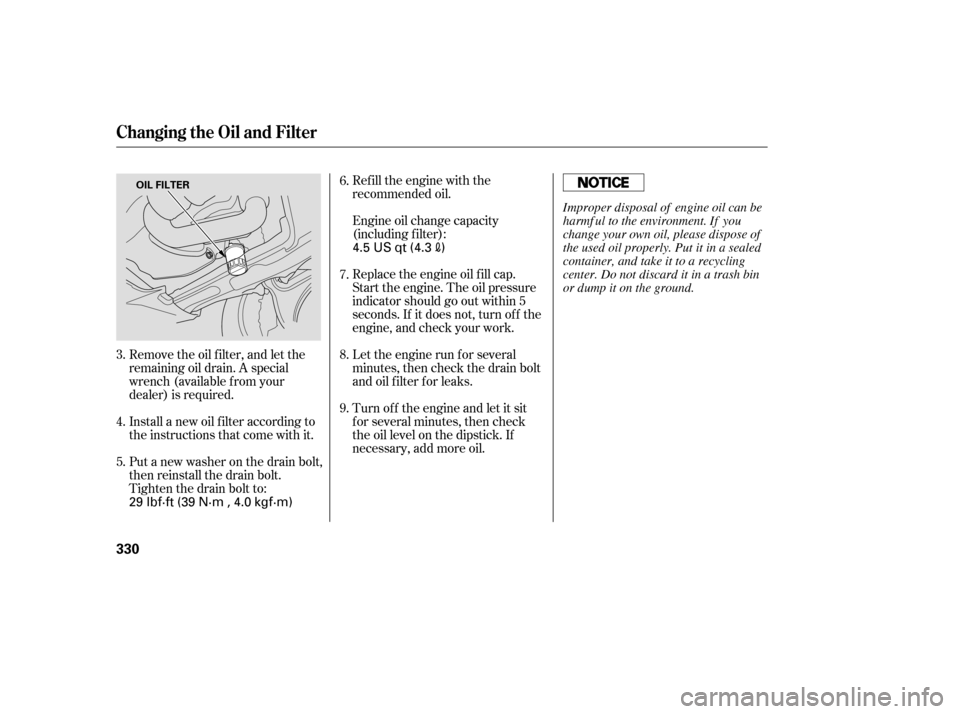
Refill the engine with the
recommended oil.
Engine oil change capacity
(including f ilter):
Replace the engine oil f ill cap.
Start the engine. The oil pressure
indicator should go out within 5
seconds. If it does not, turn of f the
engine, and check your work.
Let the engine run f or several
minutes, then check the drain bolt
and oil f ilter f or leaks.
Turn of f the engine and let it sit
f or several minutes, then check
the oil level on the dipstick. If
necessary, add more oil.
Install a new oil f ilter according to
the instructions that come with it.
Put a new washer on the drain bolt,
then reinstall the drain bolt.
Tighten the drain bolt to: Remove the oil f ilter, and let the
remaining oil drain. A special
wrench (available from your
dealer) is required.
9. 8. 7. 6.
4.
5. 3.
Changing the Oil and Filter
330
OIL FILTER
4.5 US qt (4.3)
29 lbf·ft (39 N·m , 4.0 kgf·m) Improper disposal of engine oil can be
harmf ul to the environment. If you
change your own oil, please dispose of
the used oil properly. Put it in a sealed
container, and take it to a recycling
center. Do not discard it in a trash bin
or dump it on the ground.
Page 332 of 414
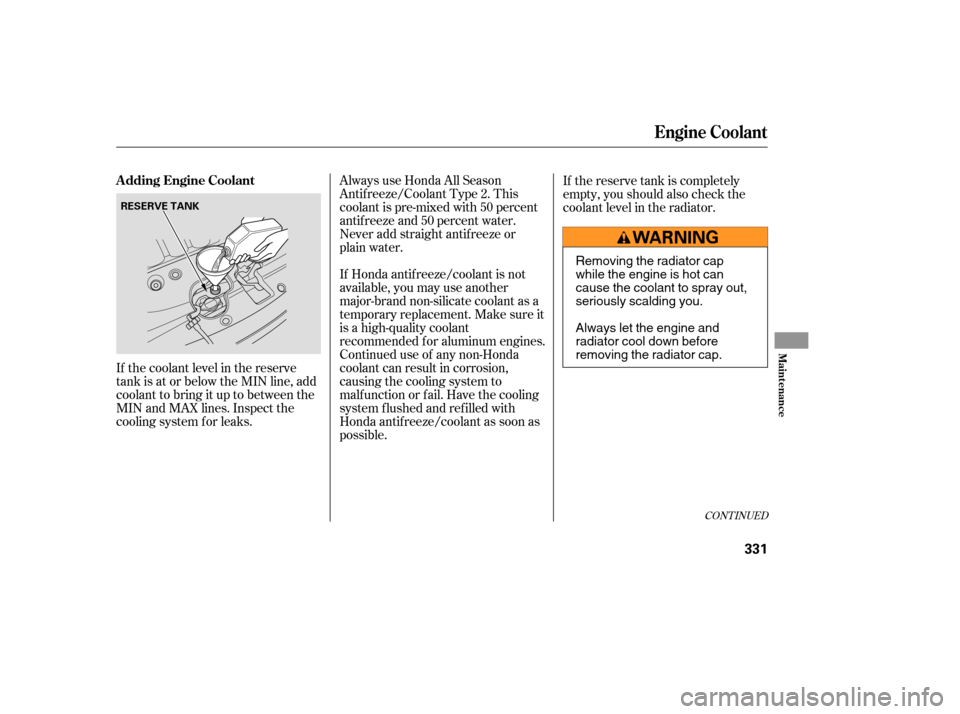
If the coolant level in the reserve
tank is at or below the MIN line, add
coolant to bring it up to between the
MIN and MAX lines. Inspect the
cooling system f or leaks.Always use Honda All Season
Antif reeze/Coolant Type 2. This
coolant is pre-mixed with 50 percent
antif reeze and 50 percent water.
Never add straight antifreeze or
plain water.
If Honda antif reeze/coolant is not
available, you may use another
major-brand non-silicate coolant as a
temporaryreplacement.Makesureit
is a high-quality coolant
recommended f or aluminum engines.
Continued use of any non-Honda
coolant can result in corrosion,
causing the cooling system to
malf unction or f ail. Have the cooling
system f lushed and ref illed with
Honda antif reeze/coolant as soon as
possible.If the reserve tank is completely
empty, you should also check the
coolant level in the radiator.
CONT INUED
A dding Engine Coolant
Engine Coolant
Maint enance
331
RESERVE TANK
Removing the radiator cap
while the engine is hot can
cause the coolant to spray out,
seriously scalding you.
Always let the engine and
radiator cool down before
removing the radiator cap.
Page 348 of 414

CONT INUED
Excessive tread wear. Cuts, splits, or cracks in the side
of the tire. Replace the tire if you
can see f abric or cord.
Youshouldgetyourowntire
pressure gauge and use it whenever
you check your tire pressures. This
will make it easier f or you to tell if a
pressure loss is due to a tire problem
and not due to a variation between
gauges.
Bumps or bulges in the tread or
side of the tire. Replace the tire if
youfindeitherof theseconditions.
Every time you check inf lation, you
should also examine the tires for
damage, f oreign objects, and wear.
Youshouldlookfor:
If you check the pressure when the
tires are hot [driven f or several miles
(kilometers)], you will see readings 4
to6psi(30to40kPa,0.3to
0.4 kgf /cm ) higher than the cold
reading. This is normal; do not
release air to match the cold
pressure. The tires will be
underinf lated.
Tubeless tires have some ability to
self -seal if they are punctured. You
should look closely f or punctures if a
tire starts losing pressure.
For convenience, the recommended
tire sizes and cold air pressures are
on a label on the driver’s doorjamb.
Tire pressure f or high speed driving
is the same as f or normal driving.
For additional technical inf ormation,
see page .
Use a gauge to measure the air
pressure at least once a month. Even
tires that are in good condition may
lose one to two psi (10 to 20 kPa, 0.1
to 0.2 kgf /cm ) per month.
Remember to check the spare tire at
thesametime. Check the air pressures when the
tires are cold. This means the
vehicle has been parked f or at least
three hours, or driven less than 1
mile (1.6 km). Add or release air, if
needed, to match the recommended
cold tire pressures.
390
U.S. Touring model
Tire Size Cold Tire Pressure for
Normal Driving
Front:
Rear:
Tires
Tire Inspection
Maint enance
347
235-710R460A
104T 33 psi (230 kPa ,
2.3 kgf/cm)
35 psi (240 kPa , 2.4 kgf/cm
)
Page 350 of 414
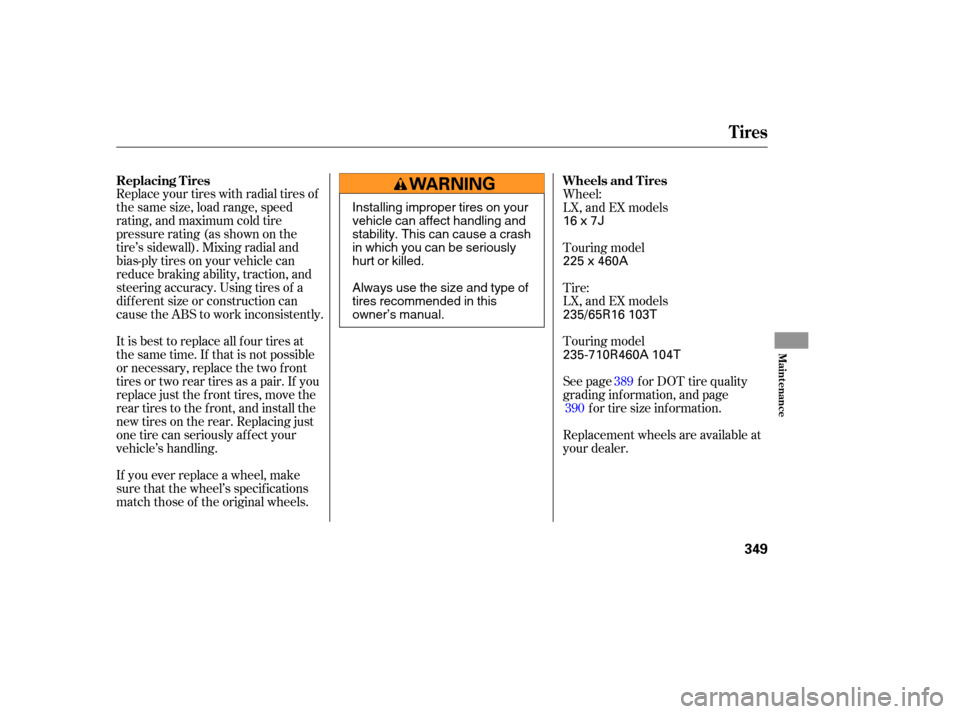
Replace your tires with radial tires of
the same size, load range, speed
rating, and maximum cold tire
pressure rating (as shown on the
tire’s sidewall). Mixing radial and
bias-ply tires on your vehicle can
reduce braking ability, traction, and
steering accuracy. Using tires of a
dif f erent size or construction can
cause the ABS to work inconsistently.See page f or DOT tire quality
grading inf ormation, and pagef or tire size inf ormation.
Replacement wheels are available at
your dealer.
It is best to replace all f our tires at
thesametime.If thatisnotpossible
or necessary, replace the two f ront
tires or two rear tires as a pair. If you
replace just the f ront tires, move the
rear tires to the front, and install the
new tires on the rear. Replacing just
onetirecanseriouslyaffectyour
vehicle’s handling.
If you ever replace a wheel, make
sure that the wheel’s specif ications
match those of the original wheels. Wheel:
Tire: LX, and EX models
Touring model
LX, and EX models
Touring model
389
390
Replacing T ires
Wheels and T ires
Tires
Maint enance
349
16x7J
235/65R16 103T 225 x 460A
235-710R460A 104T
Installing improper tires on your
vehicle can affect handling and
stability. This can cause a crash
in which you can be seriously
hurt or killed.
Always use the size and type of
tires recommended in this
owner’s manual.
Page 403 of 414
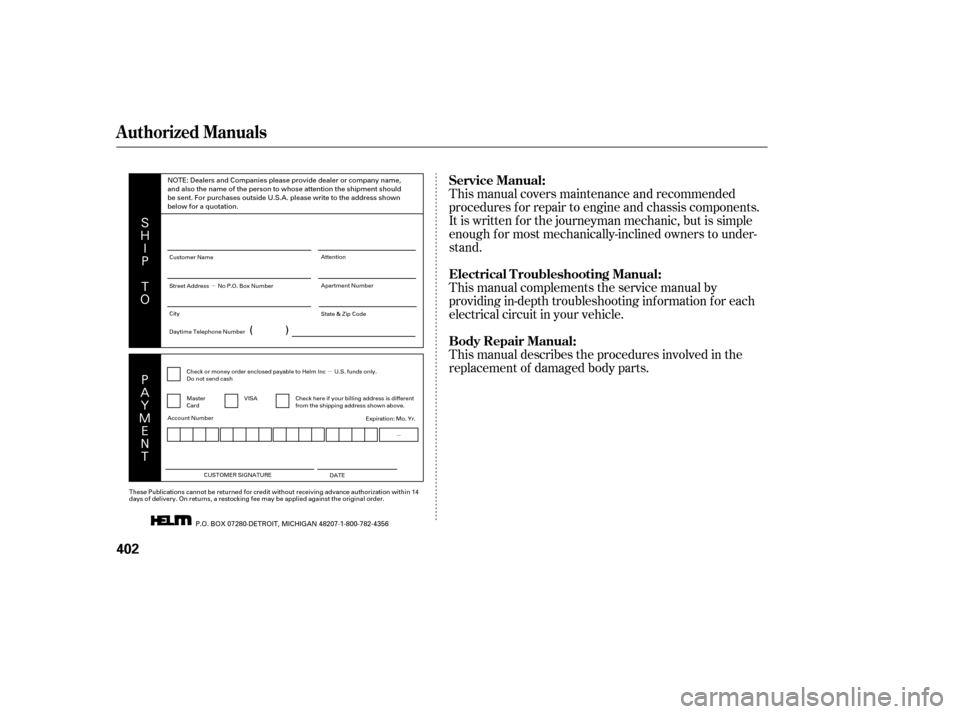
�µ�µ
�µ
�(
��
��
�%
�)
�$
�%
��
�.
�"
��
�#
�) This manual covers maintenance and recommended
procedures f or repair to engine and chassis components.
It is written f or the journeyman mechanic, but is simple
enough f or most mechanically-inclined owners to under-
stand.
This manual complements the service manual by
providing in-depth troubleshooting inf ormation f or each
electrical circuit in your vehicle.
This manual describes the procedures involved in the
replacement of damaged body parts.
Authorized Manuals
Service Manual:
Electrical T roubleshooting Manual:
Body Repair Manual:
402
NOTE: Dealers and Companies please provide dealer or company name,
and also the name of the person to whose attention the shipment should
be sent. For purchases outside U.S.A. please write to the address shown
below for a quotation.
P.O. BOX 07280·DETROIT, MICHIGAN 48207·1-800-782-4356
Customer Name Attention
Apartment Number
State & Zip Code
City
Daytime Telephone Number
Check or money order enclosed payable to Helm Inc U.S. funds only.
Do not send cash
Master
Card VISA
Check here if your billing address is different
from the shipping address shown above.
Account Number Expiration: Mo. Yr.
CUSTOMER SIGNATURE DATE
Street Address No P.O. Box Number
()
These Publications cannot be returned for credit without receiving advance authorization within 14
days of delivery. On returns, a restocking fee may be applied against the original order.
Page 414 of 414
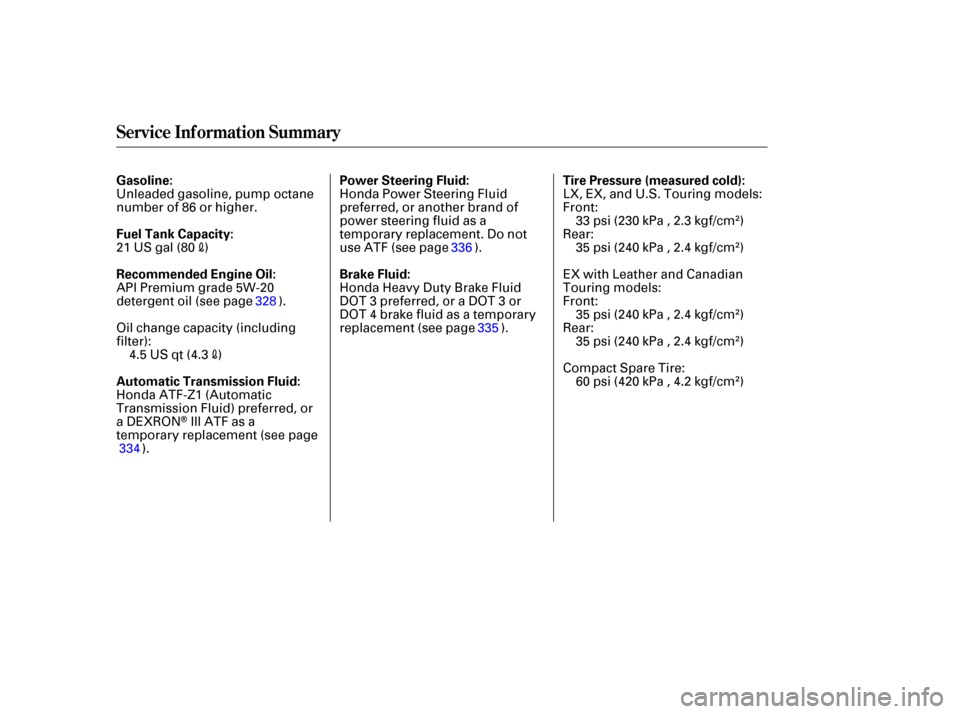
Service Inf ormat ion Summary
Gasoline:
Fuel Tank Capacity:
Recommended Engine Oil:
Automatic Transmission Fluid:Power Steering Fluid:
Brake Fluid:
Tire Pressure (measured cold):
4.5 US qt (4.3
)
Unleaded gasoline, pump octane
number of 86 or higher.
API Premium grade 5W-20
detergent oil (see page ).
Oil change capacity (including
filter):
Honda ATF-Z1 (Automatic
Transmission Fluid) preferred, or
aDEXRON
III ATF as a
temporary replacement (see page ). Honda Power Steering Fluid
preferred, or another brand of
power steering fluid as a
temporary replacement. Do not
use ATF (see page ).
Honda Heavy Duty Brake Fluid
DOT 3 preferred, or a DOT 3 or
DOT 4 brake fluid as a temporary
replacement (see page ).
35 psi (240 kPa , 2.4 kgf/cm
)
Rear: 33 psi (230 kPa , 2.3 kgf/cm
)
Front:
Front:
35 psi (240 kPa , 2.4 kgf/cm
)
Rear: 35 psi (240 kPa , 2.4 kgf/cm
)
Compact Spare Tire: 60 psi (420 kPa , 4.2 kgf/cm
)
334 336
335
328 LX, EX, and U.S. Touring models:
EX with Leather and Canadian
Touring models:
21 US gal (80
)